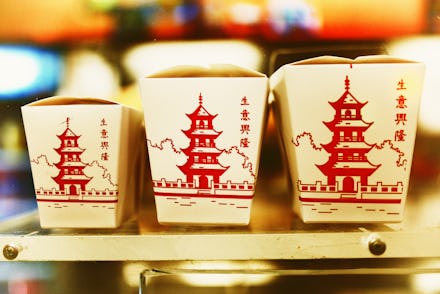Chicken soup for the conflicted Chinese-American soul

When I was growing up in Hawaii, my go-to comfort food was jook. More commonly known as congee, this savory rice porridge was the all-purpose Chinese remedy for any malady, mood or dreary day.
I can remember my mother, clad in her pajamas, as she strolled through the house announcing that she was going to make jook. She would pull out the big white rice cooker, look for leftover bean curds, pork or duck bones to toss in (essential flavor agents), and stew the whole thing for an agonizingly long time. But it was always worth the wait. My sister and I would bound into the kitchen for our bowls, I'd swirl in a long, thin stream of soy sauce and shovel in a big spoonful (ceramic, never metal) of warm, salty and velvety comfort.
Every culture has its comfort foods. Jewish matzo ball soup. French cassoulet. Brazilian feijoada — rich, soothing dishes that evoke nostalgic feelings of safety and the innocence of childhood. More than simply comforting, these foods sustain our sense of identity and anchor us to the places we call home.
As a cheeseburger-loving, second generation Chinese-American who can't speak a word of Cantonese with my grandma, I struggle with my identity. I'm not Chinese enough (whatever that means), yet I'm clearly not white. Food connects me with my heritage and my family members who endured the hardships of immigration.
I'm not alone in this. Sour, Sweet, Bitter, Spicy: Stories of Chinese Food and Identity in America, a new exhibit at the Museum of Chinese in America in New York City's Chinatown neighborhood, explores the Chinese immigrant experience through food and the desire among second-generation immigrants like me to rediscover and reconnect with their roots through the food of their forebears. Featuring custom-made ceramics representing 18 regional cuisines and videos of intimate interviews with 33 Chinese-American chefs, both professionals and home cooks, the exhibit traces the history of Chinese immigration in the U.S. — the chop suey of regional traditions, geopolitics, racism, assimilation and appropriation — through the food we brought with us.
"[The title of the exhibit] obviously refers to the delicate balance of flavors of Chinese cooking," said Audra Ang, a guest curator and author of To the People, Food is Heaven, in a phone interview, "but also the ups and downs of life" as a stranger in a strange land.
Heavy and greasy. I didn't really encounter the "Chinese food" most Americans know — lo mein, kung pao chicken, crab rangoon — until I went to college in New York City. I remember being confused — and offended — when I'd hear friends denounce all Chinese food as "heavy and greasy." The Chinese food I grew up with wasn't deep-fried wontons filled with cream cheese or chicken covered in sticky-sweet sauce. It was pork-filled dumplings my grandma would form with her nimble fingers while I watched at the kitchen counter. It was the heavy bags filled with sticky rice wrapped in lotus leaves we'd bring home from my great-grandmother's house.
The exhibit at MOCA explores that disconnect among the different iterations and interpretations of Chinese food since its arrival in 19th-century America. According to Kian Lam Kho, a guest curator whom I spoke with, some early immigrants had already opened restaurants before the Gold Rush and construction of the Transcontinental Railroad drew an influx of Chinese laborers in the 1850s and '60s.
In 1882, President Chester A. Arthur signed the Chinese Exclusion Act, putting a 10-year moratorium on entry for Chinese laborers. Many of the merchants who were allowed in ended up opening restaurants and began serving an adaptation of Chinese food for Americans seeking "exotic" tastes. From this intersection of cultures, cuisines and mythology in the late 19th and early 20th centuries came the dish that endures as the epitome of Americanized Chinese food and assimilation: chop suey.
My parents' families arrived in the U.S. with another wave of immigrants following the 1949 Communist Revolution in China. (My mother's family left Hong Kong for Boston when her older brother was just a baby, while my dad's family left Shanghai, and ended up split between Canada and New York City.) Along with the Immigration and Nationality Act of 1965 and the subsequent arrival of more affluent Chinese, many from Hong Kong and Taiwan, new strains of Chinese cooking, including spicy Sichuanese food, came to the U.S. and inspired a demand for regional cuisines.
Stir-fried. Like the people who brought them over to their new country, these foods have become integral to American culture, whether assimilated completely as generic stir-fries, pot stickers and other menu mainstays at most any national chain eatery, or preciously reinterpreted at yet another fusion restaurant. And still "authentic" Chinese food continues to be "discovered" and touted on social media as the newest culinary trend — sometimes leaving out the Chinese part of it entirely, as Ruth Tam noted in her Washington Post story on the bone broth craze.
I can't help but feel ambivalent about it all. It's frustrating to see something authentic from my cultural heritage distorted by assimilation — or outright appropriated with no acknowledgement or awareness of its origins.
At the same time, I can appreciate the desire to assimilate (cheeseburgers) and genuine attempts at cultural exchange — even when they're in the form of crab rangoon. It only affirms the authenticity of jook and sticky rice and other foods I grew up with and rely on to remind me who I am and where I come from.
"What is authentic? How do you define it?" Kho, the MOCA curator, said. "Authentic is what you grow up with, what you experience."
Exactly.